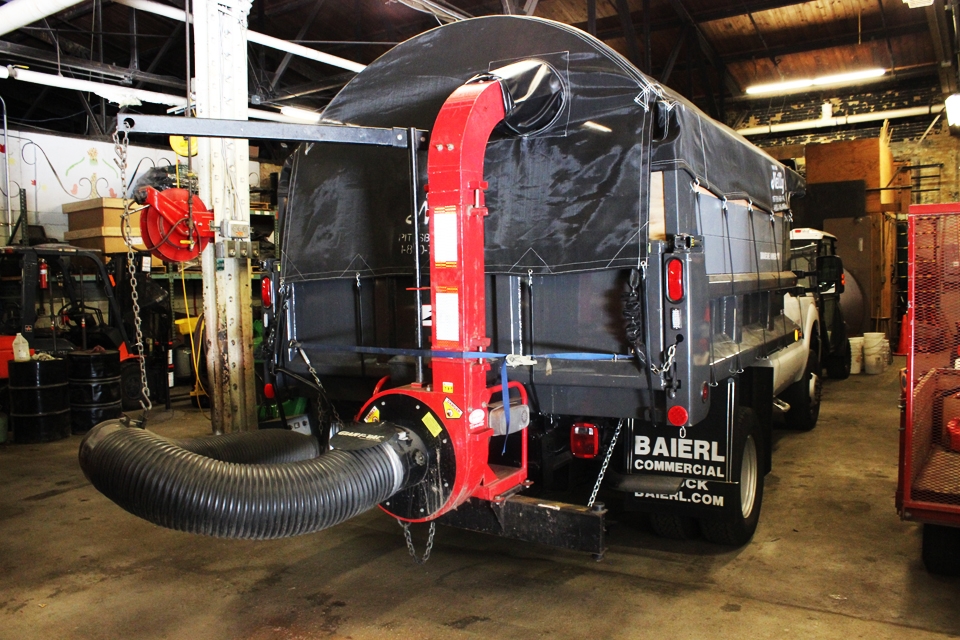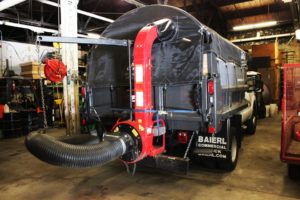

The grounds crew uses a large vacuum-like truck to gather leaves on campus.
By Esla Buehler | Staff Writer
When the leaves begin to fall, don’t expect to experience the tradition of jumping into a huge pile — at least not here at Duquesne. The groundskeeping crew has a definite process to rid campus of the nuisance that rotted, fallen leaves can cause.
It’s obvious why it isn’t practical to let the leaves collect on a college campus. Leaving them be may seem like the better choice aesthetically, but in reality, mass amounts of dead, dew-soaked leaves are far from ideal.
The scads of leaves, if left alone, would coat the lawns across campus, which is a problem for several reasons. The mask that the sheet of leaves creates eventually cuts off the grass from sunlight, making it brown and dead looking.
When wet, the leaves could also be potentially hazardous, due to the possibility of students slipping and falling. Also, the removal of leaves simply makes for a cleaner, clutter-free campus environment. All of these things, understandably, justify the school’s desire to dispose of the leaves.
This is where the grounds crew from facilities management comes in.
The silent heroes of campus, they are they ones responsible for the leaf clearing and disposal that occurs each year on campus. Grounds worker Robb Ferraro said clearing leaves on Duquesne’s campus can be challenging, especially in tight places.
Ferraro said that as far as equipment goes, they use a little bit of everything, mainly gas backpack leaf blowers and push leaf blowers. They even use a few old fashioned rakes, which he says are sometimes necessary.
The crew also has access to several electric leaf blowers. According to Ferraro, these are more environmentally sustainable and therefore assist with the department’s environmentally conscious efforts, but are currently better suited for homeowners’ yards.
“We haven’t fully moved over yet because [the electric blowers in the industry] don’t really provide the power we need,” Ferraro said.
According to Ferraro, typical procedure means blowing, or otherwise gathering, the leaves into piles and sending them into a leaf shredder, which is built into a truck that can conveniently be moved across campus.
The leaves are disposed of as efficiently as possible, depending on the circumstance, said Ferraro. Ultimately, the giant masses of leaves need to be moved out of the way as quickly as possible. They end up either at the local landfill or slightly farther away at a compost facility, which can occasionally prove to be cost-prohibitive.
“Following the school’s protocol to be environmentally responsible, we take the leaves to be composted if time and cost allows,” Ferraro said.
Though there are ten crew members typically assigned to this area of work, Ferraro said, no more than three or four are ever tasked with leaf clearing at once. Between the amount of trees and the small area to cover, the need is usually just not that demanding.
Haven’t noticed any groundskeepers tending to the leaves yet this year? This could be for one of a few reasons.
According to Coleman Griffin, manager of sustainability, grounds and motor pool in the Duquesne Department of Facilities Management, the grounds crew typically begins to prep leaf clearing equipment in late September. Griffin said the leaf clearing process continues on an as-needed basis until snow removal becomes the new priority.
In addition, Ferraro said that the grounds crew tries to strategically plan leaf clearing in between classes, to avoid the thousands of hurried students who swarm campus at specific times of the day. This is mostly due to the fact that the process is “very dusty” and already fairly space-consuming in nature.
“We’re here for the students, so we’re happy to plan around them and disappear for ten minutes when we need to,” Ferraro said.
With that approach, slipping their work in between classes, the leaves on campus quickly disappear. If you still find yourself missing those classic fall leaves even after your gratitude wears off, head over to Schenley Park and go wild.




